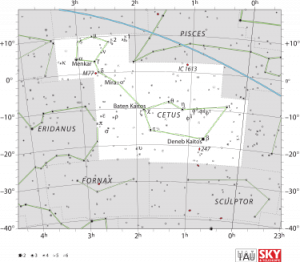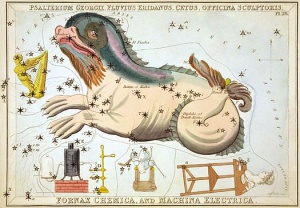Cetus

Cetus is a constellation. Its name refers to Cetus, a sea monster in Greek mythology, although it is often called 'the whale' today. Cetus is located in the region of the sky that contains other water-related constellations such as Aquarius, Pisces, and Eridanus. Although Cetus is not generally considered part of the zodiac, the ecliptic passes less than a quarter of a degree from its constellation boundary, and thus the moon, planets, and even part of the sun may be in Cetus for brief periods of time. This is all the more true of asteroids, since their orbits usually have a greater inclination to the ecliptic than the moon and planets. For example, the asteroid 4 Vesta was discovered in this constellation in 1807.
The most notable star in Cetus is Mira ("the Wonderful"), designated Omicron Ceti, the first variable star to be discovered and the prototype of its class. Over a period of 332 days it reaches a maximum apparent magnitude of 3 - visible to the naked eye - and dips to a minimum magnitude of 10, invisible to the unaided eye. Its seeming appearance and disappearance gave it its common name, which means "the amazing one". Mira pulsates with a minimum size of 400 solar diameters and a maximum size of 500 solar diameters. 420 light-years from Earth, it was discovered by David Fabricius in 1596.[1]
Cetus lies far from the galactic plane, so that many distant galaxies are visible, unobscured by dust from the Milky Way. Of these, the brightest is Messier 77 (NGC 1068), a 9th magnitude spiral galaxy near Delta Ceti. It appears face-on and has a clearly visible nucleus of magnitude 10. About 50 million light-years from Earth, M77 is also a Seyfert galaxy and thus a bright object in the radio spectrum. Recently, the galactic cluster JKCS 041 was confirmed to be the most distant cluster of galaxiesyet discovered. NGC 246 (Caldwell 56), also called the Cetus Ring, is a planetary nebula with a magnitude of 8.0, 1600 light-years from Earth. Among some amateur astronomers, NGC 246 has garnered the nickname "Pac-Man Nebula" because of the arrangement of its central stars and the surrounding star field.
Legend

Cetus may have originally been associated with a whale, which would have had mythic status amongst Mesopotamian cultures. It is often now called the Whale, though it is most strongly associated with Cetus the sea-monster, who was slain by Perseus as he saved the princess Andromeda from Poseidon's wrath. Cetus is located in a region of the sky called "The Sea" because many water-associated constellations are placed there, including Eridanus, Pisces, Piscis Austrinus, Capricornus, and Aquarius.
Cetus has been depicted many ways throughout its history. In the 17th century, Cetus was depicted as a "dragon fish" by Johann Bayer. Both Willem Blaeu and Andreas Cellarius depicted Cetus as a whale-like creature in the same century. However, Cetus has also been variously depicted with animal heads attached to a piscine body.[2]
HGS Session References
HGS Sessions - Clearing Dragon Moth Grid - 3/10/2015 [3]HGS Sessions - Clearing Tara, Gaia, Cradle of Lyra- 3/12/2015 [4]HGS Sessions - Clearing Dorado, Leo Minor, Musca, Perseus constellations - 3/23/2015 [5]
References
- ↑ Cetus
- ↑ Cetus
- ↑ HGS Session
- ↑ HGS Session
- ↑ HGS Session
Found in HGS Manual on Page 108
Found in HGS Manual on Page 115

